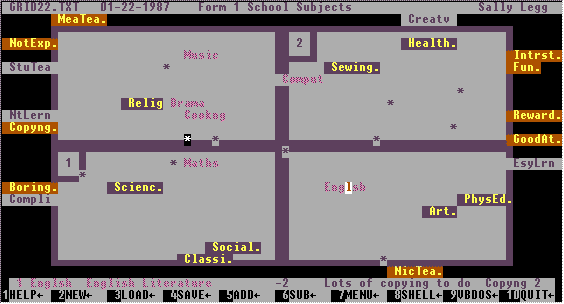

In looking at the first screen we see in the North East corner the construct "FUN". You now have to imagine there is a hyperplane running from FUN through the center and out the other side (SouthWest Quadrant). This is saying, as you can see in the second screen, that the School Subjects that score high on FUN are be placed towards the end of this imaginary vector that has the word "FUN" on it such as Health, PhysEd, Art, Sewing and the ones that score low on FUN are in the South West, e.g., Social Studies, Classical Studies and Science. The position each element takes on the individual construct lines as well as on the principal component lines is measured from where a perpendicular line drawn from the position of the element meets the particular construct or component axis.
In this tutorial case (Sally`s attitudes to her school subjects) inGridX allows you to freely explore without applying any form of preconceived conclusions. Knowing that you are dealing with a stable structure allows you to define relationships with labels that fit. It is this insight into relationships that I find most rewarding because whenever I do a grid I am expectant of being able to learn something new.
In Sally's example I concluded that her education was controlled by positive and negative learning conditions ( Interesting, Fun, Rewarding, GoodAt VS. Not explained, Complicated, Need to learn, Boring, etc.) and that secondly this was induced by the teachers relationship with Sally.
In looking at the scatter of elements (school Subjects) within the construct space a clear "What is it?" picture emerges. Although the components are fixed by Principal Component Analysis, the alignment of the picture is determined solely by the fact that the North and East directions contain the most area under the squares. This is saying in Sally's grid that the negative learning environment is outweighed by the positive in the terms expressed.
Ppressing p or P increments or decrements a scrolling list of row and
column labels and expanded descriptions. For each pair of row and column
labels, that are displayed at the bottom of the plot, there is signed cell
value and identification markers showing the exact position within the
plot of the pair of features. For large grids this made for easy identification
of a feature's exact position within the plot. If 'P' was used to pause
the toggling labels then 'p' could be used to increment just the selected
list. If toggling is then resumed by pressing Enter (see the animation
above), the display will pause again when a suspected anomaly is found
by comparing an 'off-signed' cell value with the grid's range of values.
For this reason it might be required that you need to press the F10 QUIT
key to return to the main menu. Alternatively if you press 'P' until neither
list is selected pressing Enter twice would suffice to return to the menu.